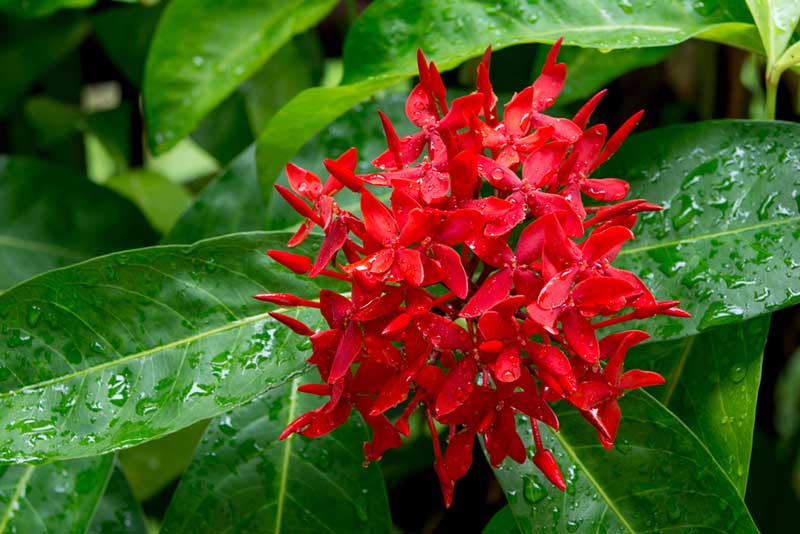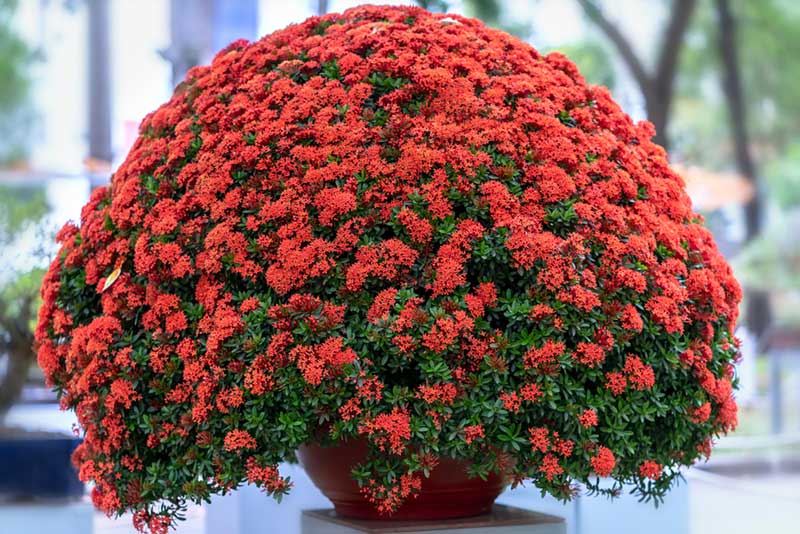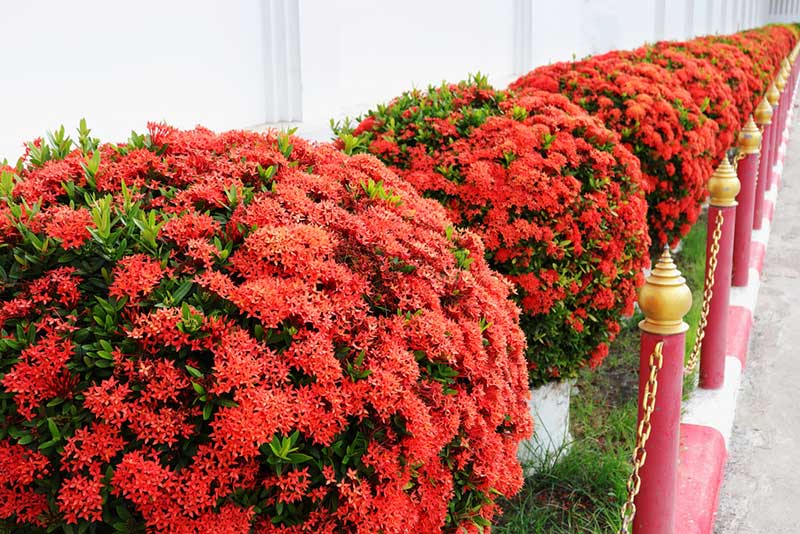
Ixora (Ixora spp.) is a tender perennial shrub that must be grown as an annual in all but USDA plant hardiness zones 10 and 11. This showy plant is prized for its clusters of bright flowers that bloom from spring until fall creating a color sensation in the garden.
Blooms consist of hundreds of tiny flowers clustered together to form a head similar to the blooming habit of hydrangea. Colors range from white or yellow to brilliant shades of pink, orange and red giving rise to the common names of “Flame of the Woods” and “Jungle Flame”.
Light and Temperature Requirements
Ixora performs best in full sun for 6 to 8 hours a day but may benefit from some shade from the midday sun in southern gardens. It will survive in partially shady locations, but blooming will be inhibited. Some varieties of dwarf ixora are more tolerant of shade, with some preferring a shady or partially shady location. Always check the light requirements of the specific cultivar before choosing a location for planting your ixora.
As a tender perennial, ixora cannot tolerate a frost and may even drop its leaves when temperatures drop into the 60s. If you are growing ixora as an annual in containers and intend to overwinter them inside the home, bring them in before cool weather arrives.

Watering
As a tropical plant, ixora prefers evenly moist soil and will suffer if the soil is allowed to dry out excessively. Water your ixoras when the soil feels dry to the touch. Mulching around the base with 2 to 3 inches of bark mulch or pine straw will help to retain moisture and provide an effective barrier for weeds.
Ixoras grown in containers may require daily watering as the soil in pots and containers can dry out quickly, especially during the heat of summer. Watch for signs of wilting and check the soil often to determine the best watering schedule for your ixoras.
Soil & Fertilizing
Ixora prefers humus-rich, well-drained soil with a pH between 5.5 and 6.5. You can typically achieve this by amending the soil with peat moss before planting your ixoras. Turn the soil to a depth of 8 to 10 inches and remove any rocks, sticks or other debris from the soil. Cover the soil with a 3- to 4-inch layer of peat moss and work it into the existing soil. The peat moss will help lower the pH of the soil while improving drainage at the same time.
If you are growing ixoras in containers, use a potting mix that contains peat moss. Equal parts peat moss, all-purpose potting soil and perlite makes a lightweight potting mixture ideal for planters and containers. Potting soil alone is too heavy for containers and will compact easily with frequent watering making it difficult for your plants to get the water and nutrients they need to thrive.
Fertilize your ixoras with fertilizer designed for acid-loving plants, such as Azalea fertilizer. Follow the application rate and frequency recommended on the product container.
Deadheading and Pruning
Ixoras may appear to be in bloom all summer, but each individual cluster blooms for several weeks and then new clusters take over. While they do not need to be deadheaded, it often improves the appearance of the plant and encourages new clusters to bloom. Pinch off old blooms as soon as they begin to fade.
Pruning can be done at any time to maintain the shape and size of the plant, but beware. Ixoras set buds for the next flush of blooms shortly after blooming. Pruning may remove the buds and prevent blooming. If your ixora has become unruly and needs serious pruning to rejuvenate it, do it early in the spring when new growth appears and before buds have had time to develop.
Propagation
Ixora can be propagated from stem cuttings in the spring. Cut a 4- to 6-inch section of new growth and remove all but 2 to 4 leaves at the growing tip. Dip the cut end of the cutting into rooting powder and shake gently to remove the excess powder. Fill a container with moist potting medium, such as seed starter or other peat-based mixture. Make an indentation in the soil and place the cutting in the soil. Firm the soil around the cutting so that it is secure.
Cover the pot and cutting with plastic wrap to hold in moisture and heat. A plastic bag or food storage bag works well as long as you poke a few holes in the bag for ventilation. Use a dowel or pencil to hold the bag away from the cutting, if necessary. Place the cutting in a warm location where it will receive moderate light. Move the cutting to more light once the roots have formed and new growth appears.

Growing Ixora from Seed
Growing ixora from seeds can be tricky, mainly because seeds are not readily available. However, your blooming ixora may produce viable seeds.
If you want to give them a try, harvest the dark berries on your ixora plants and remove the seeds.
Soak them overnight in warm water.
Plant the seed in a pot of seed starter or other planting mixture and water it to moisten the seeds and the soil.
Cover the pot with plastic and place the pot in a warm location that receives sheltered sunlight.
Keep the soil moist, but not soggy, until seedlings emerge. Keep in mind that ixora seeds may take 6 to 12 weeks to germinate and many seeds will not germinate at all.




